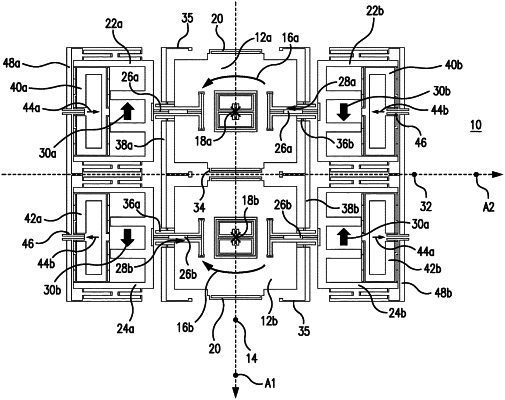| CPC G01C 19/5712 (2013.01) [B81B 3/0021 (2013.01); G01C 25/00 (2013.01); G01P 3/44 (2013.01); B81B 2201/0242 (2013.01)] | 7 Claims |

|
1. A micromechanical component for a yaw rate sensor, comprising:
a substrate having a substrate surface;
a first rotor mass developed in one piece, which is able to be set into a first torsional vibration about a first axis of rotation aligned perpendicular to the substrate surface; and
at least one first component of the micromechanical component, the first rotor mass being connected to the at least one first component via at least one first spring element, wherein the at least one first spring element extends through a lateral concavity on the first rotor mass and is connected to a recessed edge region of the first rotor mass,
wherein the lateral concavity is an indentation or a depression on a side of the first rotor mass,
a second rotor mass developed in one piece, which is realized in mirror symmetry with the first rotor mass in relation to a plane of symmetry that is aligned perpendicular to the substrate surface and centrally intersects the first rotor mass and the second rotor mass, the second rotor mass being able to be set into a second torsional vibration, phase-shifted in phase by 180° in relation to the first torsional vibration, about a second axis of rotation aligned in parallel with the first axis of rotation, the second rotor mass being connected via at least one second spring element to the at least one first component and/or to at least one second component of the micromechanical component, each of the at least one second spring element extending through a lateral concavity on the second rotor mass and being connected to a recessed edge region of the second rotor mass,
wherein the micromechanical component, as the at least one first component, has a first pair of drive structures, and, as the at least one second component, has a second pair of drive structures, first drive structures of the first pair of drive structures and the second pair of drive structures, situated on a first side of the plane of symmetry, are in mirror symmetry with second drive structures of the first pair of drive structures and the second pair of drive structures situated on a second side of the plane of symmetry, in relation to the plane of symmetry, and the first drive structure of the first pair of drive structures is able to be set into a first harmonic torsional vibration aligned in parallel with the plane of symmetry; the second drive structure of the first pair of drive structures is able to be set into a second harmonic torsional vibration, which is aligned in parallel with the plane of symmetry and phase-shifted by 180° in relation to the first harmonic torsional vibration; the first drive structure of the second pair of drive structures is able to be set into the second harmonic torsional vibration, and the second drive structure of the second pair of drive structures is able to be set into the first harmonic torsional vibration such that the first and second rotor masses are set into their respective torsional vibration with the aid of the first and second pairs of drive structures set into their respective torsional vibration,
wherein the micromechanical component additionally has a first pair of seismic masses and a second pair of seismic masses, a first seismic mass each of the first pair and the second pair, situated on a first side of the plane of symmetry, is in mirror symmetry in relation to the plane of symmetry with second seismic masses of the first pair and the second pair situated on a second side of the plane of symmetry, and the first and second pair of seismic masses are able to be set into harmonic torsional co-vibrations which are aligned in parallel with the plane of symmetry, with the aid of the first and second rotor masses set into their respective torsional vibration and/or with the aid of the first and second pair of drive structures set into their respective harmonic torsional vibration,
the first pair of seismic masses is connected to a first coupling rocker, and the second pair of seismic masses is connected to a second coupling rocker, wherein each of the two coupling rockers is pivotable about a rocker axis which is aligned perpendicular to the substrate surface.
|